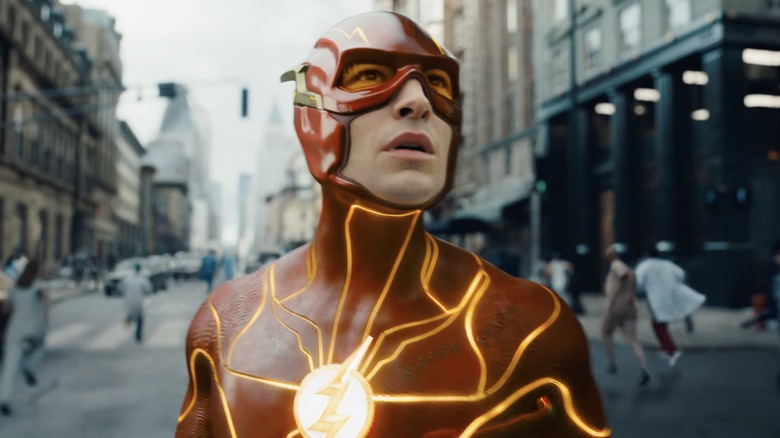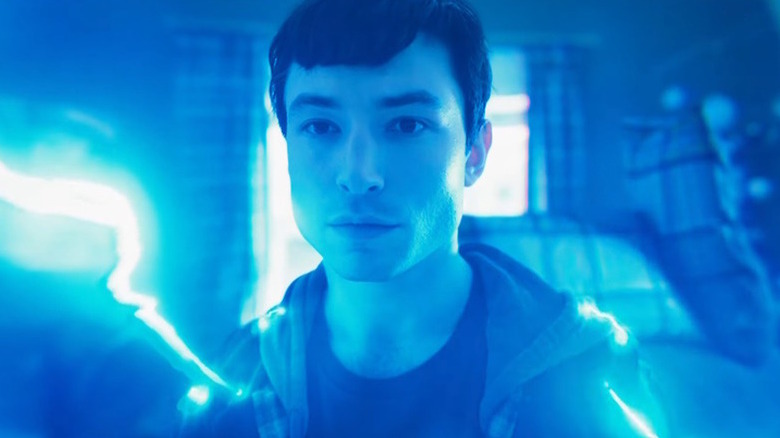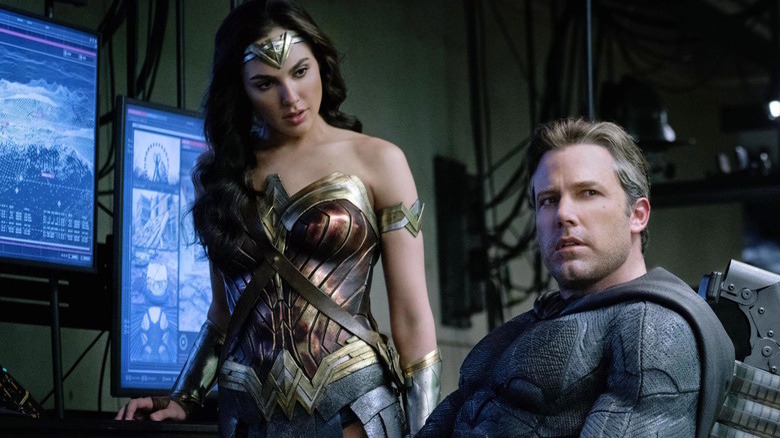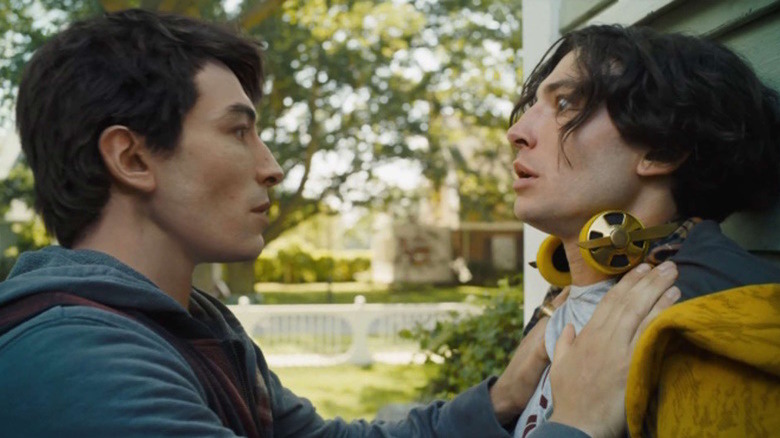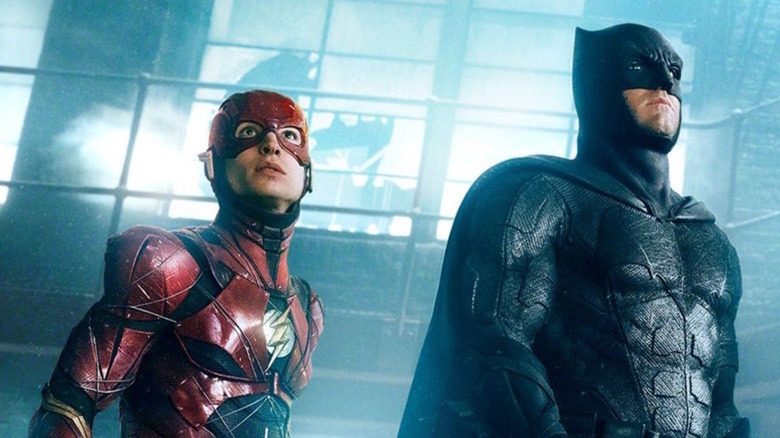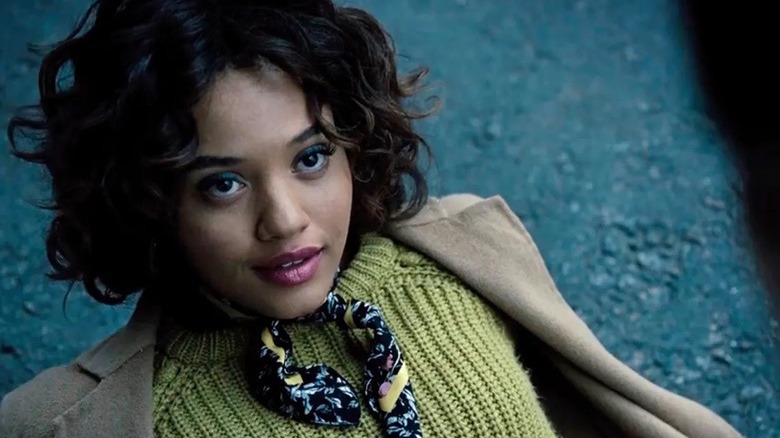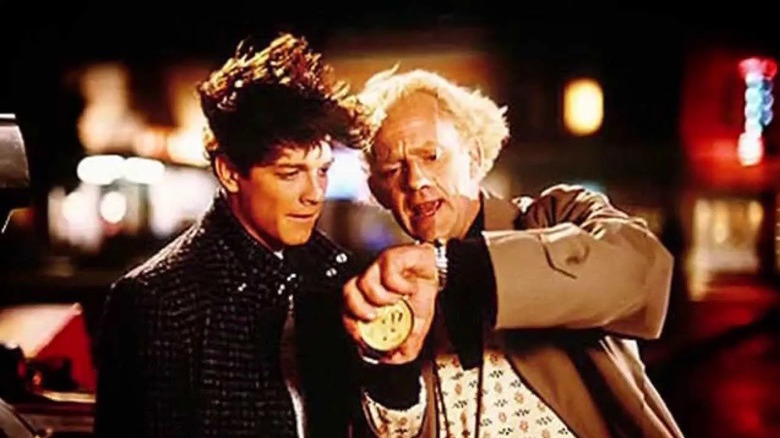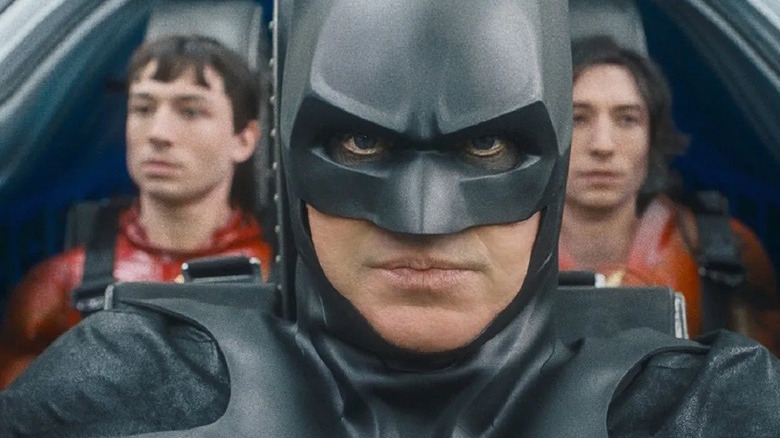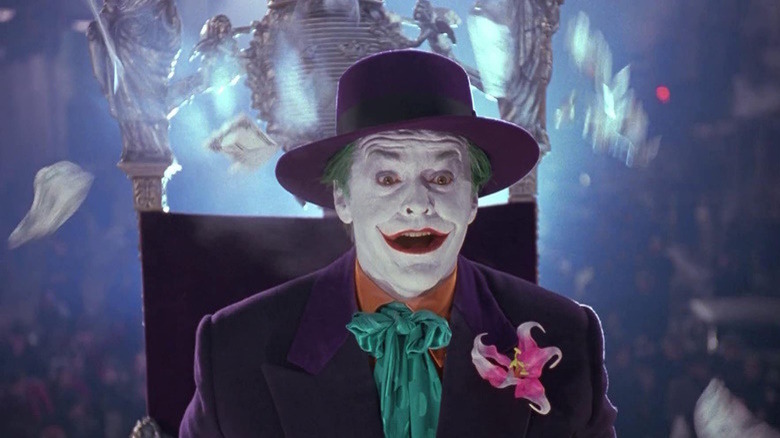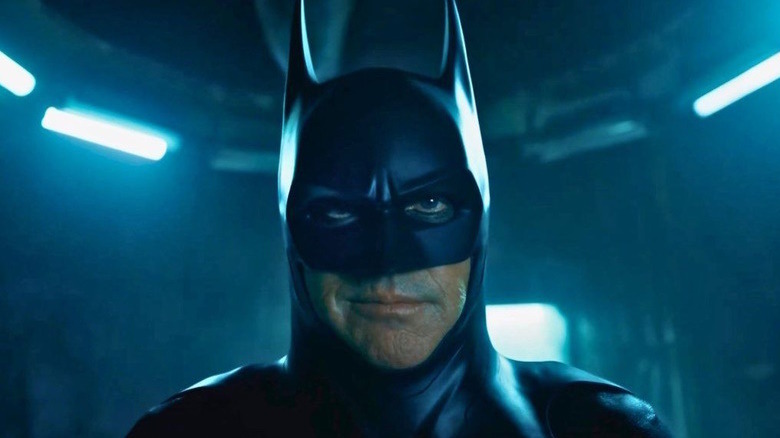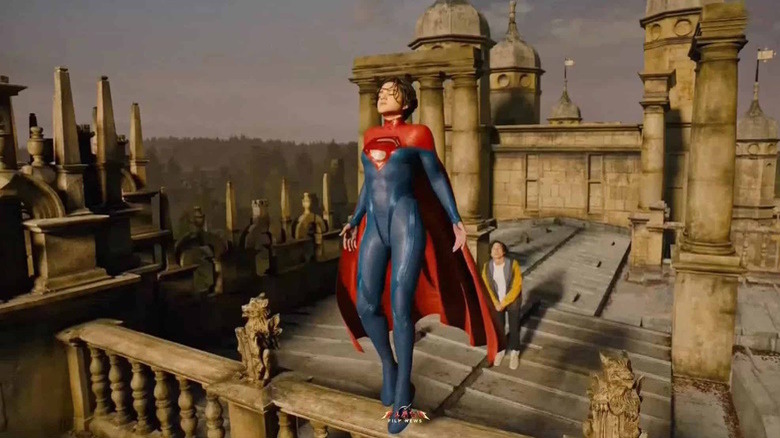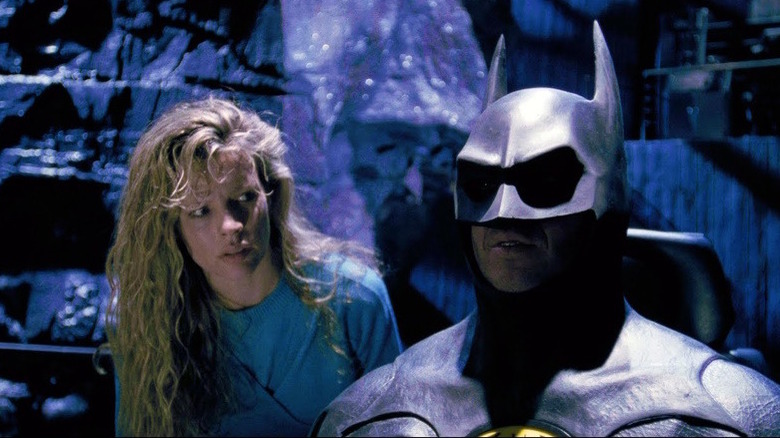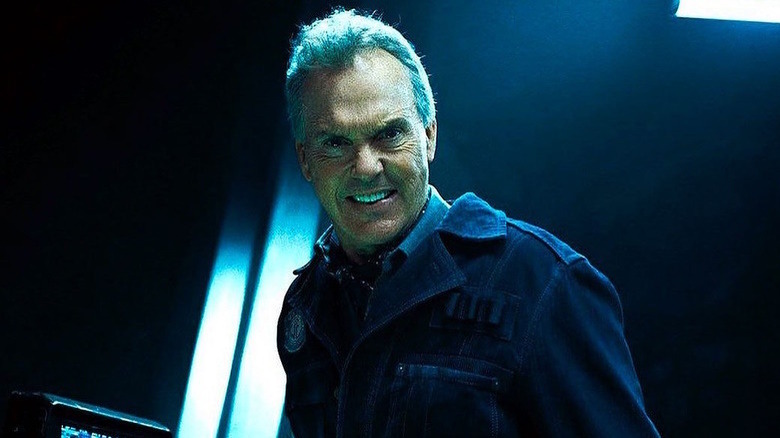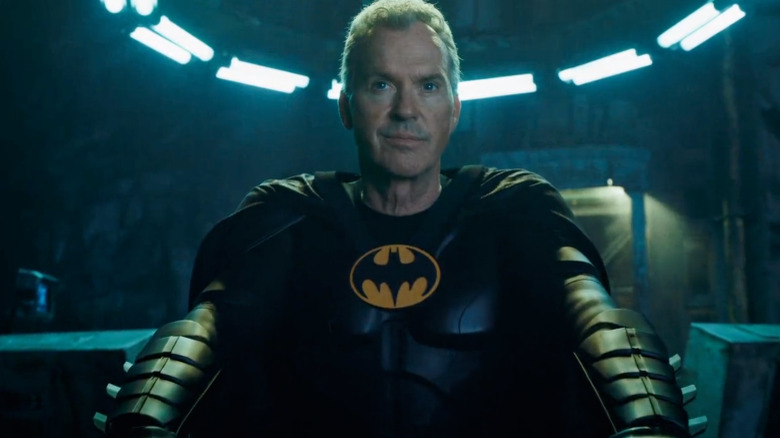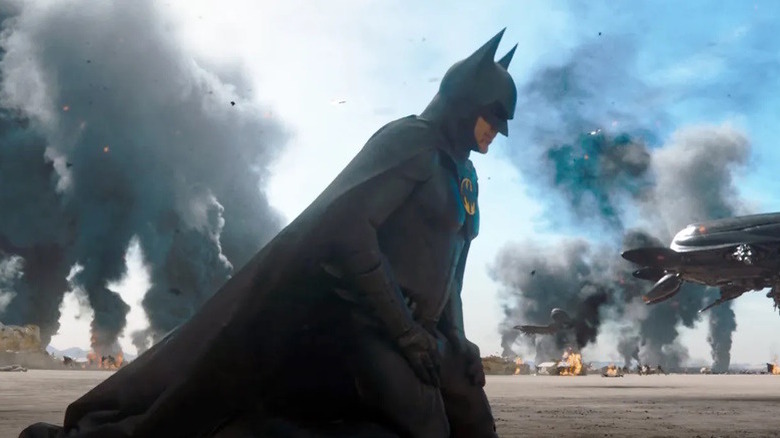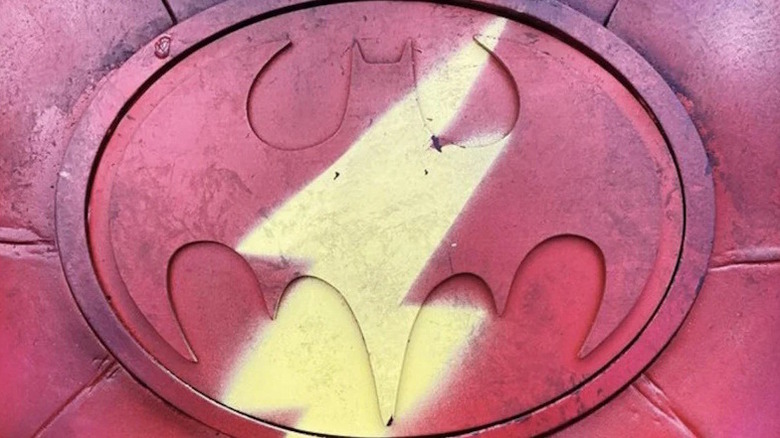The Flash Lines That Hold More Meaning Than You Think
Contains spoilers for "The Flash"
"The Flash" has come to mean a lot of different things to different audiences. For some fans of the DCEU, it represents a fresh start to the troubled cinematic universe as Barry Allen's (Ezra Miller) time-travel antics rewrite over 10 years' worth of past movie history. For fans of Michael Keaton's Batman, it's the closest we'll ever get to a third movie following "Batman" and "Batman Returns."
But for longtime DC Comics fans, many of the lines from "The Flash" pay homage to generations of classic comic book stories and tropes that get their chance to shine on the big screen, some for the very first time. Many of these Easter eggs and commentaries are hidden in lines that, upon closer examination, contain deeper meanings and references to highly cherished superhero lore. Here are our picks for "The Flash" lines that hold more meaning than you think.
Time has a pattern that it can't help reliving.
"Time has a pattern that it can't help reliving," Barry Allen tells the audience in the film's trailer. "Different people, different worlds, drawn to each other like magnets."
While Barry's words suggest certain tragedies and key events are meant to repeat themselves in his altered timeline, his words actually point toward something DC Comics has been doing for decades. Back in 1989, DC published "Gotham by Gaslight," an "Elseworlds" comic that showed a Victorian Age version of Batman tracking Jack the Ripper in 19th century Gotham City. While there were changes made to the Batman mythos, key elements — like Batman's connection to Inspector Jim Gordon and Alfred Pennyworth — were retained.
Since that time, there have been several Elseworlds comics that retell classic DC superhero stories from a unique angle, such as "The Superman Monster," where Lex Luthor creates a Frankenstein monster-like Superman creature from Kryptonian remains, or "Batman & Captain America," where Bruce Wayne and Steve Rogers team-up during World War II against the Joker and Red Skull. Despite the radically different universes, the essence of the characters remains very much the same, showing that in both the comics and movies, time needs to keep to a certain pattern.
You should seek the help of a mental health professional.
"The Flash" kicks off with a harrowing scene where Barry must save multiple babies, a nurse, and a therapy dog from falling to their deaths — all while loading up on high-calorie snacks to keep himself moving at top speed. Remarkably, he manages to save everyone, but acknowledges that the experience had to have been traumatic for everyone involved.
"You should seek the help of a mental health professional," he advises the nurse. "The Justice League isn't very good at that part yet. Trust me."
In the comics, the Justice League finally acknowledges the mental and emotional toll their activities take on their members and creates "The Sanctuary," a secret rehabilitation center for both superheroes and reformed supervillains to work through their mental issues. However, this backfires during the "Heroes in Crisis" limited series when one of the patients — later revealed to be the Flash (Wally West) — accidentally unleashes a Speed Force energy blast that kills multiple patients. So ... yeah. Seems like there's still room for improvement.
Sorry I'm late.
Although "The Flash" is Barry Allen's first solo superhero movie, it also functions as a send-off for many versions of DCEU characters, including Ben Affleck's Batman, Jason Momoa's Aquaman, and Gal Gadot's Wonder Woman. The Amazon Princess receives a small cameo at the beginning of the film where she arrives at the last minute to save Batman from falling with her Lasso of Truth (which also causes both Batman and the Flash to become unexpectedly honest about their large egos and virginity status).
Diana later apologizes for her lateness — which could be read as an in-joke for the way she's being used in other DCEU movies. Gadot also showed up in "Shazam! Fury of the Gods" (2023) earlier this year, but only for the final funeral scene after Billy Batson was killed and needed to be resurrected by a god. Wonder Woman might be one of the DCEU's more popular heroes, but her blink-or-you'll-miss-them cameos show she's being featured in increasingly sparse ways.
This is my face. You stole my face.
Along with a host of surprise cameos and guest stars, "The Flash" gives us not one, but two Barry Allens played by Ezra Miller. In the film, Barry travels back in time to prevent his mother's death but while racing back to the present, he gets thrown into an alternate 2013 where an eighteen-year-old Barry Allen variant is heading home to drop off a load of laundry. When the two Barrys meet, the younger version freaks out, telling his older self, "This is my face. You stole my face."
Although young Barry comes around and eventually teams up with the older Flash, he later reveals a dark side when he becomes obsessed with traveling back in time and preserving his world, even going up against the older Barry when he tries to stop him. This causes him to fill a role akin to "The Reverse-Flash," a Flash villain from the comics and TV show who has similar speed abilities to the Flash.
Interestingly, in the comics, the first Reverse-Flash Eobard Thawne (aka "Professor Zoom") started out as a fan of Barry Allen's Flash. He even had plastic surgery to make himself resemble Barry and recreated the accident that gave Barry his powers. Thus, when young Barry accuses his older counterpart of stealing his face, he's making a bizarre commentary on what he will become.
Barry, these scars we have make us who we are. We're not meant to fix them.
After Barry tells Ben Affleck's Bruce Wayne that he can travel through time and potentially save their parents from dying, Bruce cautions him against trying to "fix" the timeline, stating that such traumatic events help define a person.
"These scars we have make us who we are," Bruce explains. "We're not meant to fix them."
We see exactly what Bruce means later when Michael Keaton's Batman stitches himself up and gazes at all the scars he's accumulated after a lifetime of crime fighting. More tellingly, during the climactic fight scene, Barry's younger counterpart gets sliced across the face by a Kryptonian blade and starts getting shards of Kryptonian metal embedded in his body every time he goes back in time to try and change the past. Ultimately, he becomes a monstrous half-metallic being with a scarred face, despite his healing abilities.
After seeing what his actions have turned him into, the younger Barry saves his older counterpart by letting his future self stab him, effectively erasing both of them from time. Even so, Barry is unable to completely restore the timeline to what it used to be, showing that some scars really can't be healed.
Do we marry her?
Actress Kiersey Clemons returns to the role of Iris West after shooting unused scenes with Ezra Miller for "Justice League" (2017), which were later re-edited into the 2021 Snyder Cut. In "The Flash," we learn that Iris and Barry went to college together and Barry had a huge crush on her, although they didn't really start connecting until she became a reporter and started following his father's court trial.
After Barry alters the timeline by saving his mother, however, we learn that an alternate Barry is set to have a date with Iris on the very day he's destined to be struck by lightning and gain his powers. When he discloses this, the younger Barry excitedly asks his older self if he's married to Iris in the future.
While this sadly isn't that Barry's destiny, Iris West does become Barry's wife in multiple continuities, including several comic book storylines and the CW TV series. In some early stories, the two briefly retire in the future and have twins, while Iris' nephew Wally West becomes Flash's sidekick, Kid Flash, eventually inheriting the title of the Flash.
Marty McFly is Eric Stoltz.
Although Barry tries to only make the smallest changes to the timeline to save his mother, he starts to suspect that his actions had larger consequences when he discovers that Eric Stoltz — not Michael J. Fox — played Marty McFly in the "Back to the Future" movies of this reality. To make things weirder, in this timeline, Michael J. Fox got Kevin Bacon's part in "Footloose" while Kevin Bacon was cast as Maverick in "Top Gun" instead of Tom Cruise.
Oddly enough, some of these alterations do have a basis in our reality. Fans of "Back to the Future" know that Eric Stoltz was originally cast as Marty McFly and even filmed some scenes before the filmmakers decided to replace him with Michael J. Fox. And while there's no indication that Michael J. Fox was ever up for Kevin Bacon's part in "Footloose," both Fox and Bacon were considered for the part of Maverick in "Top Gun."
The movie trivia what-ifs don't end there. During the movie's climax, we get to see glimpses of several alternate universes, including one where Nicolas Cage plays a version of Superman battling a giant spider. Those who've seen the documentary "The Death of 'Superman Lives': What Happened?" know that Cage was indeed up for the part of Superman in a never-made movie slated to be directed by Tim Burton. Writer Kevin Smith also discloses that producer Jon Peters wanted Superman to fight a giant spider during the climax. It may have taken breaking the DC Universe, but Peters finally got his wish — and Cage got to add another superhero role to his resume after playing both Ghost Rider and Spider-Man Noir.
What it is? It's a hot mess. It's a crapshoot.
Different metaphors have been used to explain the intricacies of time travel. In the "Flashpoint" limited series, Barry Allen compares altering the past to swimming up a waterfall. In the "Loki" Disney+ TV show, time constantly splits into new branches like a giant tree. However, in "The Flash," Michael Keaton's Bruce Wayne compares time to something more mundane: a bowl of spaghetti.
According to Bruce, when you change history, you don't simply cause time to branch into a single new reality: You fracture reality entirely by causing timelines to mix together like noodles. This alters the past, present, and future, forming a multiverse that is, in Bruce's words, "a hot mess."
On one level, Bruce's metaphor can be seen as keeping with the spaghetti imagery that runs throughout the movie. Barry initially broke time by making sure his mother got the tomatoes she needed to cook pasta so his father wouldn't leave on the day of her murder and the family wouldn't be ruined "for a can of tomatoes."
However, audiences can also view Bruce's "hot mess" speech as a commentary on the current state of DC movies. With producers like Zach Snyder and James Gunn offering wildly divergent creative visions for the DC movie universe, the films have varied greatly in terms of tone and quality, while offering very little in the way of cohesive direction. "The Flash" has fun with this by having Keaton, Affleck, and even George Clooney reprise their versions of Batman in one film, yet by doing so, it also acknowledges that DC storytelling has gotten very messy.
This bag laughs.
Production designers from "The Flash" took pains to recreate iconic set pieces and vehicles from Tim Burton's "Batman" films, including the Batmobile, Batwing, and even the Wayne Manor kitchen where Bruce Wayne and Vicki Vale (Kim Bassinger) finished their first date. However, one item gets a special shout-out — the Joker's laughing bag.
In the movie, the younger Barry eagerly explores the Batcave and combs through Bruce's extensive trophy collection. He tries to show one of these items to his older counterpart, telling him, "This bag laughs."
While older Barry brushes this off, longtime fans will recognize this bag as the prank "laughing bag" that the Joker (Jack Nicholson) hid in his jacket so he could continue laughing even after falling to his death at the end of "Batman." It would seem Batman claimed the bag later on, just so he could keep the Joker's "last laugh" as one of his trophies. Iconic!
Yeah. I'm Batman.
No appearance by Michael Keaton's Batman would be complete without the iconic line from his 1989 introductory scene: "I'm Batman."
Fans fell in love with the line, and virtually every actor who's played Batman, from Christian Bale to Val Kilmer to Kevin Conroy, has repeated it at some point in their "Batman" films. At the time of shooting "Batman," however, the line was just one of many options. Other scripted lines included "I am the night" (which was used in the movie novelization by Craig Shaw Gardner) and "I am vengeance" (which Robert Pattinson used in "The Batman").
However, when neither Burton nor Keaton was satisfied with the written lines, Keaton improvised the line "I'm Batman" during shooting — and the rest is history.
In "The Flash," the line is used after Barry convinces Bruce to come out of semi-retirement and don the Batsuit again. As Batman makes his grand entrance, he utters the line for the first time with a smile, showing that the OG Batman is indeed back — and he couldn't be happier about it.
The Last Son of Krypton. I was sent to protect him.
The two Barrys and Batman get the surprise of their lives when they break into a Russian base to free Superman and instead find his cousin Kara aka Supergirl (Sasha Calle). When asked to explain her relationship to Kal-El, Kara reveals that she is Kal-El's cousin, who was sent to protect the Last Son of Krypton but got captured by humans instead.
This might confuse audiences who don't know the history between Superman and Supergirl — and in truth, it gets kind of confusing even for long-time comic book readers. In early stories, Kara Zor-El was born after Krypton exploded, as her home Argo City escaped its destruction. Later, she was sent to Earth and met her older cousin Superman, eventually adopting a human disguise and her Supergirl persona.
However, in more recent comic book and TV canon, Kara was born before Kal-El and even babysat for him as she grew up on Krypton. When the planet exploded, both Kal-El and Kara were sent to Earth — but Kara got caught in a time warp or was stuck in suspended animation, causing her to arrive on Earth as a teenager although Kal-El had since aged into an adult Superman.
"The Flash" changes events yet again by establishing that in this timeline, Kara and Kal escaped Krypton simultaneously, but Kal's ship was intercepted by General Zod (Michael Shannon) who killed the infant Superman. Kara subsequently gets held in a Russian prison for decades (much like the alternate Superman of the "Flashpoint" comic book storyline), explaining why she emerges much more bitter toward humanity when Barry saves her.
How much do you weigh?
Keaton's Batman may have made a lot of improvements to his gadgets since 1989 — but he still uses some old favorites, like the grapple gun he used to lift Vicki Vale and himself away from the Joker's goons during their chase scene.
Before they can get away, however, Bruce needs to accurately calibrate the gun, so he asks Vicki how much she weighs. Flustered, the photojournalist lies, claiming she only weighs "about 108," causing the gun to stall and leave them hanging in mid-air. To save Vicki, Batman has to let go and take on multiple assailants, nearly getting himself killed in the process. Later, he tracks her down muttering, "You weigh a little more than a 108."
Fortunately, in "The Flash," Barry's more pragmatic, so when Batman asks him the same question, the hero not only provides accurate estimates of his weight, his past self, and Supergirl, but he also adds up the figures, saving Batman from doing the calculations. This allows them to escape in record time, showing it pays to be honest — and a math whiz.
Want some help?
Keaton's Bruce Wayne may have initially dismissed Barry Allen, but he eventually warms up to the Flash after Barry reveals he traveled through time to save his mother. Acknowledging that he also got into crime fighting to avenge his parents, Bruce offers to help Barry recover his superpowers.
This references the original "Flashpoint" comic book storyline the movie is based on. In this story, the Batman of the Flashpoint universe — who turns out to be Bruce's still-living father Thomas — also helps Barry recover his speed by recreating the accident that first made him the Flash. In both the comic and the movie, this involves strapping Barry into an electric chair during a lightning storm and letting a bolt of lightning hit him. (The movie even adds a bat-shaped kite into the mix, giving the mad scientist experiment Ben Franklin vibes).
In both versions, Barry gets badly electrocuted but insists on going again. The movie shows him finally recovering his powers after Supergirl flies him directly into the lightning storm and Barry's younger counterpart gives him a charge of Speed Force energy. The Beatles may have made the phrase, "I get by with a little help from my friends" famous, but they probably never had this scenario in mind.
You want to get nuts? Let's get nuts.
Fans may have gone nuts when Keaton repeated his famous "I'm Batman" line, but he also gets to use some other classic lines that have since become a major part of the character. Back in 1989, Keaton's Bruce Wayne confronts Jack Nicholson's Joker when the Clown Prince of Crime invades Vicki Vale's apartment. Unable to access his usual armored suit and gadgets, Bruce makes do by hiding a metal plate under his shirt and then gets the Joker to shoot him by intentionally aggravating the villain.
"You wanna get nuts?" Bruce dares the Joker. "C'mon! Let's get nuts!"
The line has since been parodied, first by Adam West in his animated movie "Batman: Return of the Caped Crusaders" when West's "Bright Knight" Batman goes a little crazy and starts imitating his darker counterparts. Will Forte's "LEGO Batman" also uses the line in "The LEGO Batman Movie" and even starts playing a "Let's Get Nuts" music mix before he beats up all the Joker's goons.
In "The Flash," Keaton uses the line after Barry convinces him to join his rag-tag Justice League, consisting of the two Barry Allens, Kara Zor-El, and Batman. This leads into the third act where the group takes on an army of Kryptonians. Hey, if that's not nuts, we don't know what is.
I can't bring you back.
One of the most heartbreaking scenes in "The Flash" is when Barry discovers that although he can travel through time, he can't prevent certain deaths from happening. He realizes this when he and his younger counterpart go back in time to save Batman and Supergirl after they see them fall in battle. Although they're able to prevent Bruce and Kara from immediately dying, both heroes still end up getting killed a short time later in different ways.
Kneeling by the dying Batman, Barry attempts to resuscitate him, but finally acknowledges, "I can't bring you back."
Bruce's response? "You already did." While this could be understood as Bruce Wayne showing gratitude toward Barry Allen for bringing him out of retirement, there's also a meta-reading here as "The Flash" finally provided Keaton with the third Batman movie he never got to make back in the 1990s.
It's a bit more loose.
"The Flash" sees the cinematic introduction of one of the Scarlet Speedster's best gadgets — a ring that holds a compressed version of his friction-resistant costume. In the 2022 DC prequel comic book series "Flash: Fastest Man Alive," we learn Barry got this version of the ring from Wayne Enterprises, but he loans it to his past counterpart after temporarily losing his powers in the lightning storm that gives the younger Barry his superhuman speed.
Young Barry later returns the ring to the older Flash after he regains his abilities, but what will the younger Flash wear now? No problem — after raiding the Batcave, young Barry gets his hands on one of Bruce Wayne's Batsuits and modifies it into a Flash suit by spray painting it red and sawing off the cowl's ears. Barry's rather proud of his new costume and shows off its flexibility, commenting that "It's a bit more loose" than the original Flash suit.
His words are incredibly ironic for anyone who's heard stories from all the past actors who've worn the incredibly tight and cumbersome Batsuit. Keaton felt very claustrophobic in his suit and had to turn his entire body just to see his scene partners. Val Kilmer recalled he couldn't hear anything in his costume and had to have people help him stand up and sit down. Christian Bale thought he was about to have a panic attack in the suit and had to have help going to the bathroom. Clearly, the Batsuit feels way more comfortable in the movie universe than in the real world. Or maybe Keaton's older Bruce Wayne just had a lot of time to get the tailoring just right.
